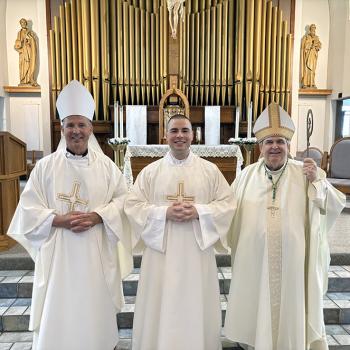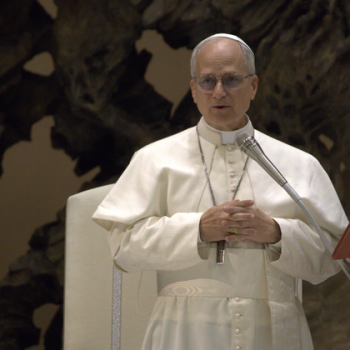It is that time of the year again: Trinity Sunday. As my seminary professor admits, it is a day that many young priests simply do not look forward to, because they have to give a homily about “three in one and one in three”! How can one condense a mystery of our faith in a 12-minute homily? Our modern way of thinking prevents us from being comfortable with merely accepting something as a fact without any evidence. We live in a scientific world where all claims made have to be accompanied by empirical or rational demonstrations that meticulously prove their existence. It is important for us to understand that the Trinity has been and will remain a mystery of faith and that it is our outlook on the Trinity that can aid us in making this mystery relevant in our everyday lives.
Charity and the Trinity – Families as “little trinities”
Let us approach the subject of the Trinity by talking about love, or more appropriately, agape or charity: Christian love. When we start talking about the Trinity, we are really delving into the mystery of who God is. Perhaps we can start with Sacred Scriptures, since the first letter of Saint John tells us that God Himself is love (4:8). Let us follow the epistle with what the medieval theologian Richard of St. Victor had to say about love:
“No one is properly said to have charity on the basis of his own private love of himself. And so it is necessary for love to be directed toward another for it to be charity.” [1]
Let us look at the love existing between married couples as an example. It cannot be said that love exists in a marriage if one of the spouses only loves himself or herself. Rather, we come to the conclusion that true love exists in a marriage when the love is mutual or reciprocal—in other words, when both spo uses constantly give of themselves to the other for the sake of their love for one another. Although the spouses share commonly in the marital love, they still retain their individual identities and their roles also remain distinct from one another: the husband remains a male in nature and the protector of the household while the wife remains a female and the caregiver. On the other hand, we also know that one of the primary functions, so to speak, of marriage is to bring new life to the world. Hence, marital love cannot exist if it is self-contained—the love between husband and wife becomes richer when it is poured out in their children. This is what we mean when we say that children are the fruit of the love of their parents. When children are born, they enter into the mutual love of their parents and participate in it yet they remain distinct individuals with their different personalities and tastes. In this manner, there is one love that unites the parents and their children yet there are three distinct persons (mother, father and children) that participate in that common bond.
uses constantly give of themselves to the other for the sake of their love for one another. Although the spouses share commonly in the marital love, they still retain their individual identities and their roles also remain distinct from one another: the husband remains a male in nature and the protector of the household while the wife remains a female and the caregiver. On the other hand, we also know that one of the primary functions, so to speak, of marriage is to bring new life to the world. Hence, marital love cannot exist if it is self-contained—the love between husband and wife becomes richer when it is poured out in their children. This is what we mean when we say that children are the fruit of the love of their parents. When children are born, they enter into the mutual love of their parents and participate in it yet they remain distinct individuals with their different personalities and tastes. In this manner, there is one love that unites the parents and their children yet there are three distinct persons (mother, father and children) that participate in that common bond.
With this example, we can start to see how we can use the concept of love that exists in the family to understand the dogma of the Trinity. Augustine said that “If you see charity, you see the Trinity.” [2] Augustine also believed that the Trinity was indeed a mystery and that we were not going to fully understand it in this life; however, he still thought that we could find analogies for the Trinity in our lives by finding traces or vestiges of it in creation, because man is made in the image of God (Gen 1:27). Hence, we can use the family as an analogy for the Trinity, but at the same time we have to be careful. Because it is an analogy it has its own limitations in providing us with a true understanding of the Trinity, and that the reality of God will still remain a mystery of our faith.
If we take the words of Augustine as our starting point, then we should be able to “see” the Trinity in the love that exists within a family. As mentioned above, all three persons in a family—mother, father and child—share in one love and yet the three persons remain distinct from one another with different roles and personalities. We can also carefully apply this understanding to the Trinity. In the Trinity, there is one God and three different persons with different roles. It is the infinitely reciprocal love that exists within the Trinity that keeps the three divine persons together. At the same time, each person of the Trinity has a distinct role or mission. The Father sent the Son to reveal Himself to the world (Jn 20:21) and the Son left us the Advocate or the Holy Spirit (Jn 14:16) before He returned to the Father.
It is important to remember the Trinity in terms of relationship. Just as the words “mother”, “father” or “child” in themselves imply relationships (a mother or father cannot be understood without a child and viceversa) the three divine persons—Father, Son and Holy Spirit—cannot be grasped when taken out of context of their relationships to one another. The Father loves the Son and the Son loves His Father and the Holy Spirit is the love—the common bond—that unites the Father and the Son. The Holy Spirit is the fruit of the reciprocal and infinite love that the Father and the Son share in common.
True Images: Our Participation in the Trinity
 What about the times when we cannot see love in a family? Can we always see the Trinity in family love? Perhaps not. This is why it is of utter importance to restore the true meaning of marital love and family relationships in a world where, for the most part, motherhood and fatherhood has been reduced to a mere biological accident. We also have to restore friendships and human relationships in general and ensure they remain true, sincere and just instead of being false and filled with greed and hidden interests. As the then-Joseph Cardinal Ratzinger said in one of his essays, “If God does not reflect Himself in his image, then He cannot be thought of.” [3] We have to conduct ourselves in a way that others can think of God when they meet us. Our relationships with others have to serve as windows for others to see and come to know God through them. If we truly live as we were meant to live by our Creator, as made in his image, then we will reflect Him everywhere we go, and we will show to the world that God is alive and present everywhere. In this way, we will be the true images of a God Who is far from being abstract or isolated, and we will reflect instead a God who is familiar and is relational and even calls us “friends” (Jn 15:15). When our relationships are governed by charity, we will also make known a God who is Himself love (1 Jn 4:8) and Who is, accordingly, Father, Son and Holy Spirit. It is through love—charitable reason rather than scientific reason— that Christians can make the triune God known to the world.
What about the times when we cannot see love in a family? Can we always see the Trinity in family love? Perhaps not. This is why it is of utter importance to restore the true meaning of marital love and family relationships in a world where, for the most part, motherhood and fatherhood has been reduced to a mere biological accident. We also have to restore friendships and human relationships in general and ensure they remain true, sincere and just instead of being false and filled with greed and hidden interests. As the then-Joseph Cardinal Ratzinger said in one of his essays, “If God does not reflect Himself in his image, then He cannot be thought of.” [3] We have to conduct ourselves in a way that others can think of God when they meet us. Our relationships with others have to serve as windows for others to see and come to know God through them. If we truly live as we were meant to live by our Creator, as made in his image, then we will reflect Him everywhere we go, and we will show to the world that God is alive and present everywhere. In this way, we will be the true images of a God Who is far from being abstract or isolated, and we will reflect instead a God who is familiar and is relational and even calls us “friends” (Jn 15:15). When our relationships are governed by charity, we will also make known a God who is Himself love (1 Jn 4:8) and Who is, accordingly, Father, Son and Holy Spirit. It is through love—charitable reason rather than scientific reason— that Christians can make the triune God known to the world.
_____________________________________________________
[1] Richard of St. Victor, De Trinitate in Richard of St. Victor: The Book of the Patriarchs, The Mystical Ark, and Book Three of the Trinity, trans. Grover A. Zinn (New York: Paulist Press, 1979), III.2.
[2] Augustine, De Trinitate, VIII.5.12.















